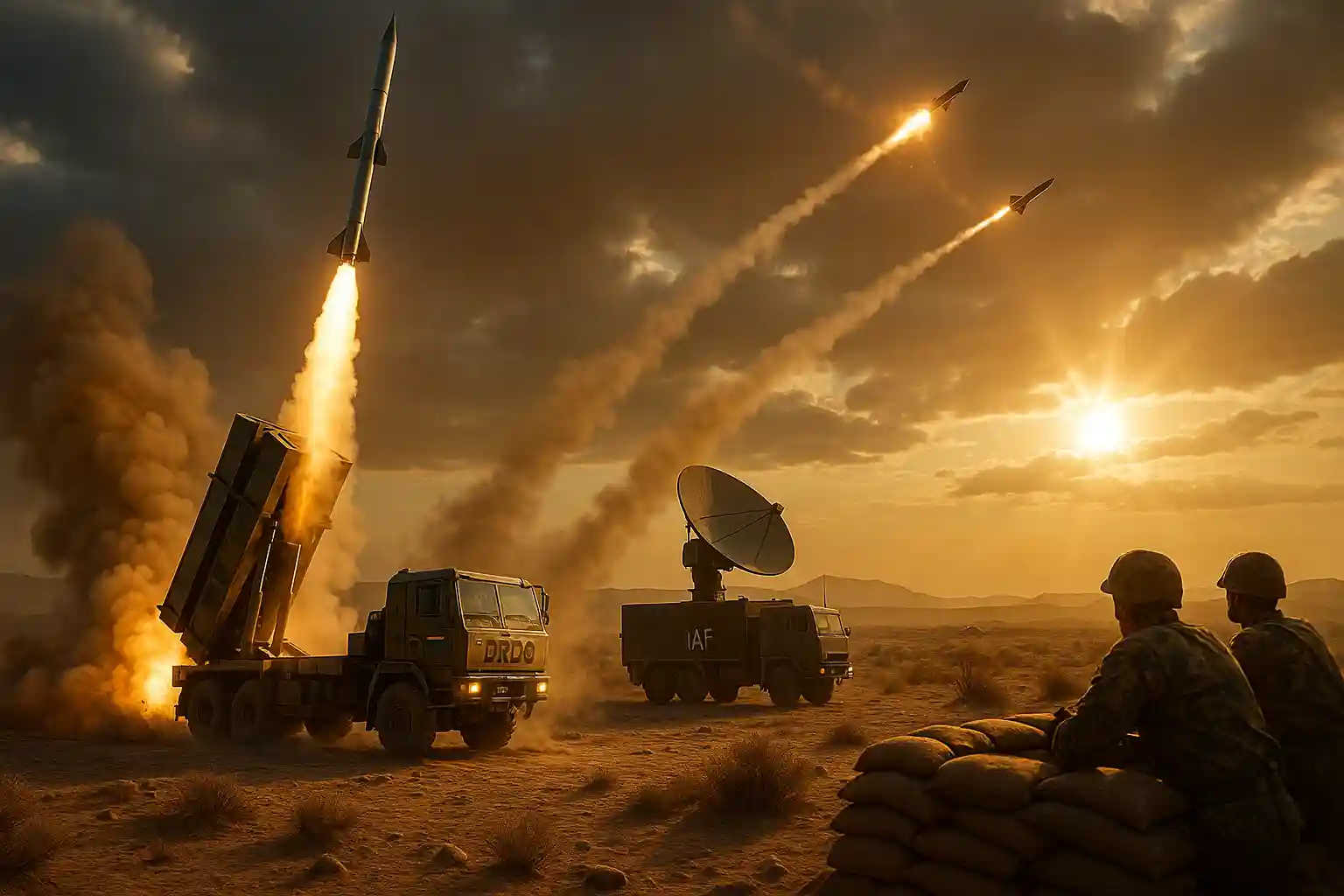As a defence enthusiast, I often ask myself: what will truly make India self-reliant in defending its skies? For years, I watched as we depended on foreign systems like the S-400, THAAD, or even Israel’s Iron Dome. They were powerful, but they were not ours.
Now, India has answered that question with Project Kusha, officially known as the Extended Range Air Defence System (ERADS). For me, this is more than a missile system. It is the bold heart of Mission Sudarshan Chakra, a national initiative to develop an indigenous, multi-layered missile shield that spans from the Himalayas to the vast Indo-Pacific.
Key Takeaways
- Mission Sudarshan Chakra is India’s vision for a nationwide, indigenous missile defence network by the 2030s.
- IADWS (Integrated Air Defence Weapon System) was the first step, providing short-to-medium range coverage.
- Project Kusha (ERADS) forms the outer shield, with interceptors covering 150–400 km.
- The M1 interceptor will undergo its first test in 2026, followed by M2 in 2027 and M3 in 2028.
- A naval variant will protect Indian carrier groups and fleets in the Indo-Pacific.
Mission Sudarshan Chakra: India’s Layered Shield
When Prime Minister Narendra Modi announced Mission Sudarshan Chakra, it was more than a project. It was a vision to secure India’s skies with an indigenous, multi-layered air and missile defence system by 2035.
- The Integrated Air Defence Weapon System (IADWS) was the first step, covering short-to-medium range threats with missile launchers, electro-optical sensors, and directed-energy measures.
- Project Kusha now takes centre stage as the long-range shield, intercepting stealth aircraft, UAV swarms, cruise missiles, and hypersonic anti-ship ballistic missiles (ASBMs).
Together, IADWS and Kusha are shaping India’s version of an Iron Dome + S-400 hybrid, but customised for Indian geography and strategy.
Why India Needs Project Kusha Now
The need for Kusha is urgent.
- Regional threats are intensifying: China is deploying hypersonic glide vehicles and expanding its stealth fleet, while Pakistan fields cruise missiles designed to evade radar.
- Import dependence is risky: India’s S-400 deliveries slowed due to the Ukraine war, exposing the danger of relying on foreign systems.
- Cost matters: Buying more imported systems would drain billions of dollars. India needs a scalable and cost-effective indigenous solution.
For me, Kusha is more than defence hardware. It is India’s insurance policy against future wars, ensuring our skies are protected by technology built in India, for India.
What is Project Kusha?
Project Kusha (ERADS) is a mobile, long-range missile defence system designed by DRDO with BEL as the prime integrator.
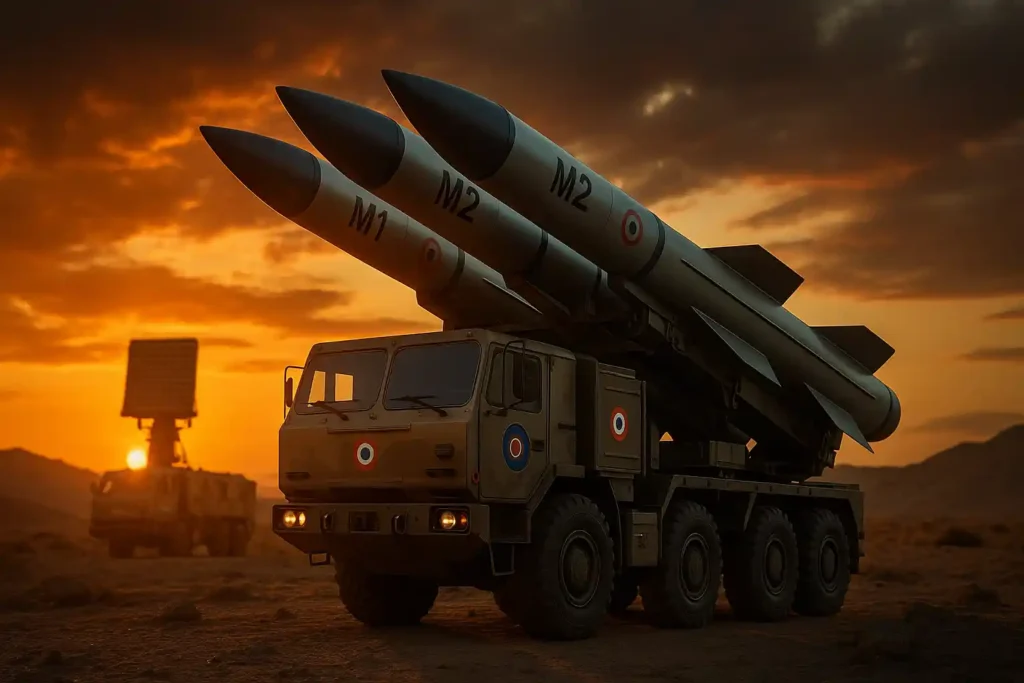
It fills the gap between the MR-SAM (80 km) and the S-400 (400 km), while introducing:
- Satellite-linked fire control via IACCS integration.
- AI-driven sensor fusion to handle saturation attacks.
- Directed-energy modules to blind drones and enemy optics.
Kusha is not just tactical cover. It is India’s strategic aerospace fortress.
Interceptor Variants: M1, M2, M3 – A Layered Approach
Kusha’s layered defence comes from three interceptor families, each designed for a unique role.

M1 Interceptor – Tactical Defender
- Range: 150 km
- Role: Protects forward bases, cities, and command hubs from aircraft, drones, and cruise missiles.
- Status: First live test in 2026 (revised from 2025).
- Significance: Fills the gap between Akash-NG and MR-SAM. Provides fast reaction against saturation attacks by drones and missiles.
M2 Interceptor – Mid-Tier Guardian
- Range: 250 km
- Role: Counters stealth aircraft, UCAV swarms, and glide bombs.
- Status: Trials expected in 2027.
- Significance: Serves as the mid-layer wall, intercepting threats before they reach critical Indian assets.
M3 Interceptor – Strategic Hunter
- Range: 350–400 km
- Role: Eliminates AWACS, refuellers, and hypersonic ASBMs.
- Status: Likely trials in 2028.
- Significance: Works as a strategic denial weapon, crippling the enemy’s ability to coordinate deep strike operations.
Shared Kill Vehicle Features:
- Dual-pulse solid rocket motors for extended thrust.
- AESA radar with infrared dual guidance to defeat stealth targets.
- Thrust Vector Control (TVC) for extreme manoeuvrability.
- Fragmented warhead optimised for maximum kill probability.
This modular design ensures cost efficiency while maintaining flexibility across roles.
S-400 vs Project Kusha: Can India’s Indigenous Shield Outperform Russia’s Best?
Akash Prime Missile: Why This Inner-Ring Defence Matters More Than Ever
Technologies Behind Kusha

AESA Surveillance & Fire Control
Tracks 150+ airborne targets simultaneously, giving commanders a comprehensive battlespace view. This allows India to prioritise and neutralise UAV swarms, stealth aircraft, and cruise missiles together.
Electro-Optical Protection & Laser Dazzlers
Introduced in 2025 upgrades, these directed-energy systems can blind enemy optics and drones, reducing the need for expensive missile launches.
IACCS & Satellite-Aided Cueing
Links into the Integrated Air Command and Control System (IACCS), enabling data sharing with S-400 radars, AWACS, and DRDO BMD systems. This creates a network-centric shield that is extremely hard to jam.
High Kill Accuracy
Designed for high single-shot probability of kill, with salvo launches increasing effectiveness to more than 95%, ensuring survivability against saturation attacks.
IADWS First Test: India’s Bold Step Towards Missile Sovereignty
Mission Sudarshan Chakra: India’s Sky Shield Explained
Seamless Integration with the Indian Defence Ecosystem
Project Kusha is designed to plug into India’s wider defence architecture, ensuring complete layered coverage across land, sea, and air. It will be integrated with:
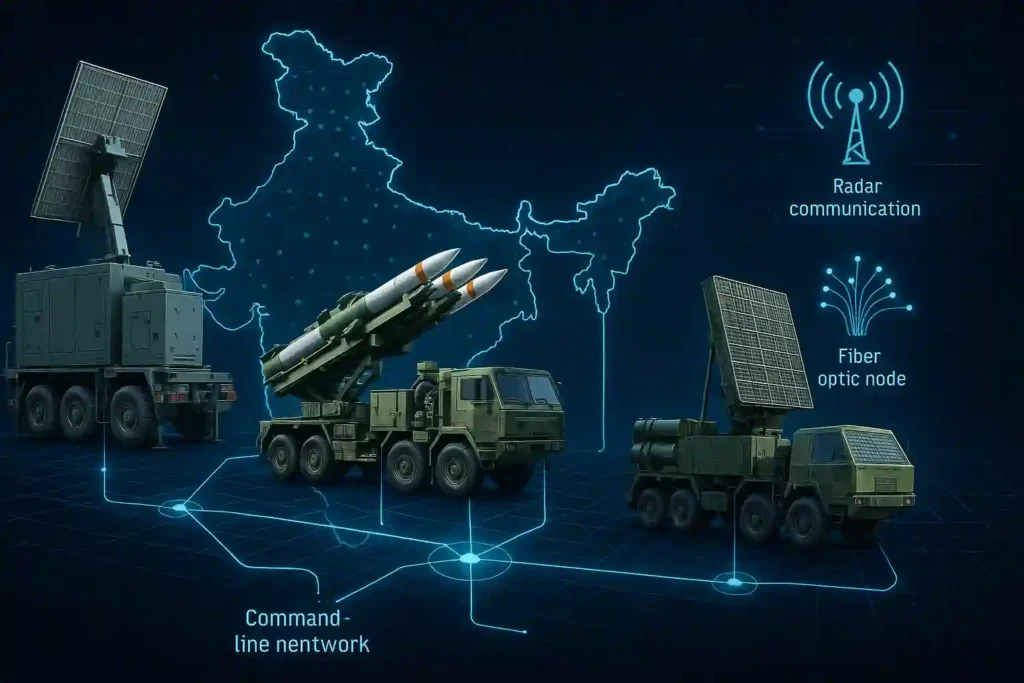
- IACCS (Integrated Air Command and Control System), the backbone of the Indian Air Force’s command grid.
- S-400 radar networks, creating a combined picture of long-range threats.
- Akash and Akash-NG missile batteries, forming the inner defence layers.
- DRDO BMD radars, extending surveillance to ballistic threats.
- BharatNet fibre-optic backbone, providing secure communication and data links.
With AI-powered fire control and real-time sensor fusion, Kusha will operate as a responsive, decentralised, and highly resilient shield, making it virtually unjammable even in electronic warfare environments.
Project Timeline & Development Milestones
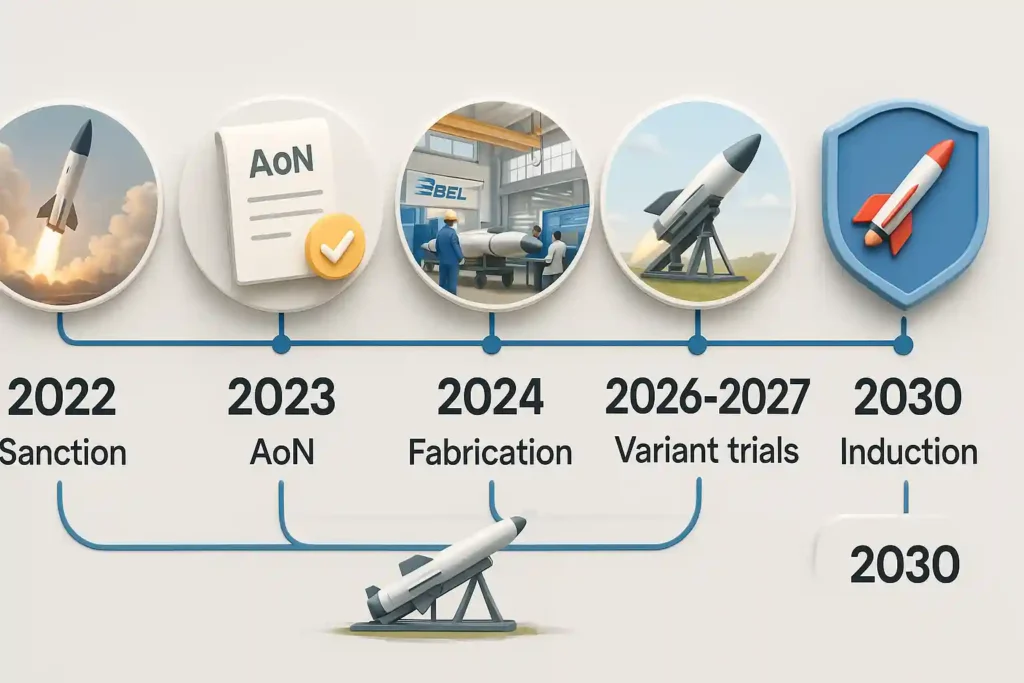
- May 2022: CCS clears Project Kusha.
- Sept 2023: ₹21,700 crore approved for 5 IAF squadrons.
- Aug 2024: Fabrication of M1 interceptors begins.
- June 2025: Portable launchers deployed at Dhamra Test Range.
- 2026: First M1 interceptor test (revised from 2025).
- 2027: M2 trials.
- 2028: M3 trials.
- 2028–2030: Induction into the IAF and Navy.
This timeline matches Mission Sudarshan Chakra’s target of a nationwide shield by 2035.
Naval Variant: Extending Kusha to the Seas
Kusha is also being adapted for naval warfare.
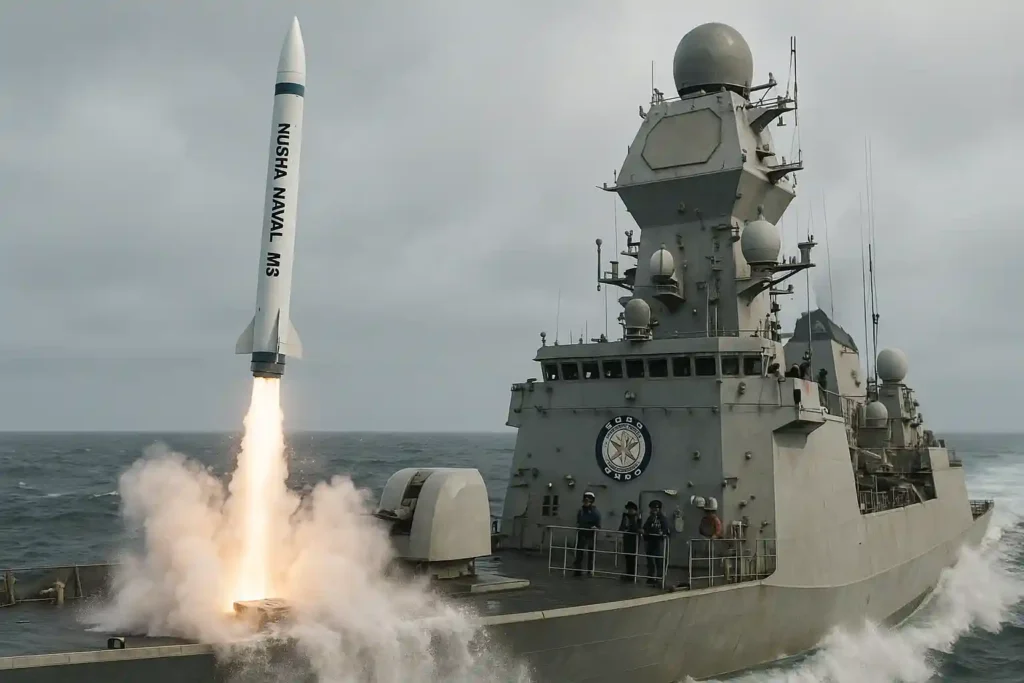
- Range: 250+ km
- Launch System: Vertical Launch System (VLS)
- Role: Protects aircraft carriers and destroyers from hypersonic ASBMs and strike bombers.
- Integration: Works with the Navy’s LR-SAM and fleet radars.
In the Indo-Pacific, where China’s DF-21D “carrier-killer” missile poses a threat to fleets, a naval Kusha could be the decisive shield for India’s blue-water Navy.
INS Arnala: India’s New Coastal Defender
Tejas Mk1A Deliveries Begin: What It Means for India’s Air Power
Strategic Significance: Why Kusha Matters

- Self-Reliance in Defence: Ends dependence on imports and strengthens Atmanirbhar Bharat.
- Built for Indian Terrain: Optimised for Himalayan altitudes, deserts, and coastal zones, unlike imported systems designed for Europe.
- Export Growth Driver: Affordable and modular, Kusha could become a flagship export to nations in Asia, Africa, and the Middle East.
- Deterrence Posture: With a 400 km range and the ability to counter hypersonic threats, Kusha strengthens deterrence against China’s PLARF arsenal and Pakistan’s missile systems.
Global Comparisons: A New Peer Among Giants
While still in its prototype stage, Kusha has already drawn comparisons to:
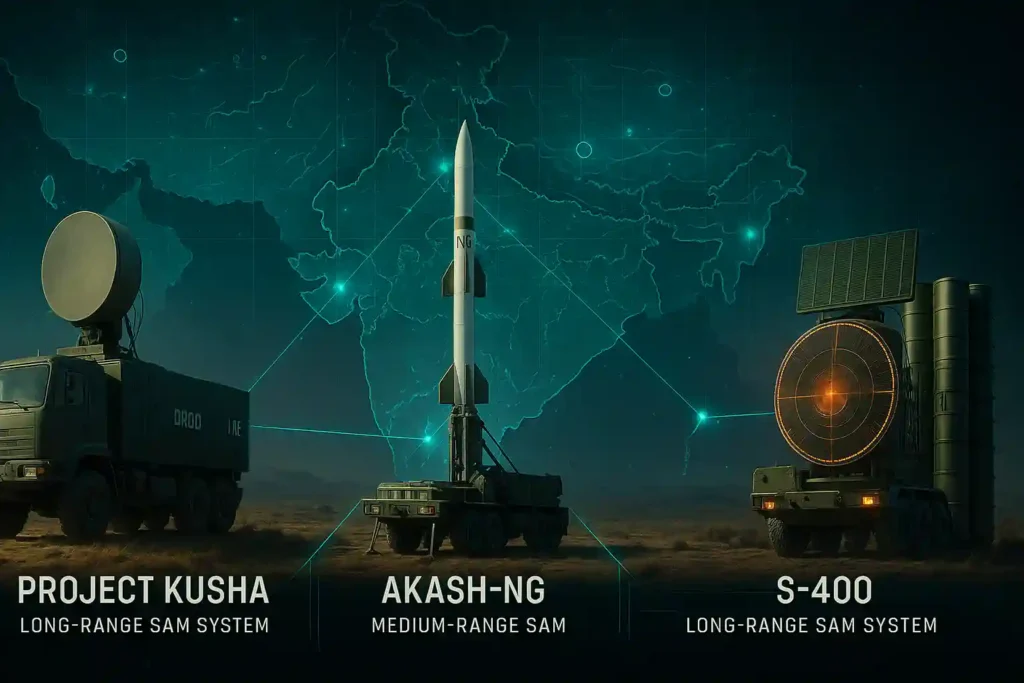
| System | Range Band | Distinguishing Edge |
|---|---|---|
| S-500 (Russia) | 500+ km | Exo-atmospheric coverage |
| THAAD (USA) | 200+ km | High-altitude, hit-to-kill |
| Patriot PAC-3 | 70–160 km | Combat-proven NATO shield |
| Iron Dome (Israel) | 70 km | Rocket and artillery defence |
| Kusha (India) | 150–400 km | Indigenous, AI-integrated, terrain-optimised |
Challenges on the Horizon
Despite its promise, Project Kusha must overcome:

- Testing Delays: The M1 trial, pushed from 2025 to 2026, shows subsystem maturity challenges.
- Seeker & Sensor Fusion: Needs to prove dual guidance effectiveness against stealth aircraft in jamming-heavy conditions.
- Electronic Warfare Robustness: Must withstand Chinese and Pakistani ECM suites on platforms like the J-20 and J-16.
- Industrial Scale-Up: BEL and partners must deliver squadrons on time, avoiding past bottlenecks seen in Tejas and Akash programmes.
- Tri-Service Integration: Smooth coordination between the IAF, Navy, and Army will be essential for success.
Technical Specifications Snapshot
- Booster Diameter: 320 mm (M1), 450 mm (M3)
- Propellant: Indhan-1 composite
- Target Speed Handling: Up to 2,300 m/s
- Interception Altitude: 25 km
- Network Protocols: MIL-STD-1553B compliant
What Experts Are Saying
“Project Kusha aims to make India self-sufficient in layered air defence systems. Its integration with IACCS and flexibility across terrains make it globally competitive.” – Dr. Samir Kamat, DRDO Chairman
“Prototype delivery is on track. Upcoming trials will prove Kusha’s superiority against stealth and high-velocity threats.” — BEL CMD, May 2025 Interview (BharatShakti)
FAQs: Quick Answers for Curious Readers
1. When will Kusha be deployed?
M1 test in 2026, with induction phased through 2028–2030.
2. Will it replace the S-400?
No. It will complement the S-400, but may surpass it in some roles.
3. How does it fit with IADWS?
IADWS covers short-range defence. Kusha is the long-range shield.
4. Is there a naval version?
Yes. A VLS-launched naval variant is being developed.
5. What is the cost?
Phase 1: ₹21,700 crore, Phase 2: around ₹40,000 crore for additional squadrons.
Conclusion: India’s Sky Shield Takes Shape
With IADWS forming the inner ring and Kusha extending defence into the outer shield, India’s Mission Sudarshan Chakra is becoming one of the world’s most ambitious air and missile defence programmes.
The M1 interceptor test may have slipped to 2026, but the vision remains intact. By 2030, India could field a fully indigenous, layered missile shield covering land, sea, and high-altitude theatres.
For me, Project Kusha is India’s declaration of missile sovereignty. From the Himalayan borders to the Indo-Pacific seas, it promises unmatched protection and the pride of being 100% Made in India.
